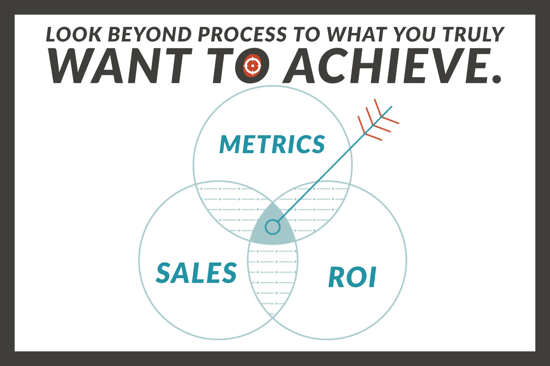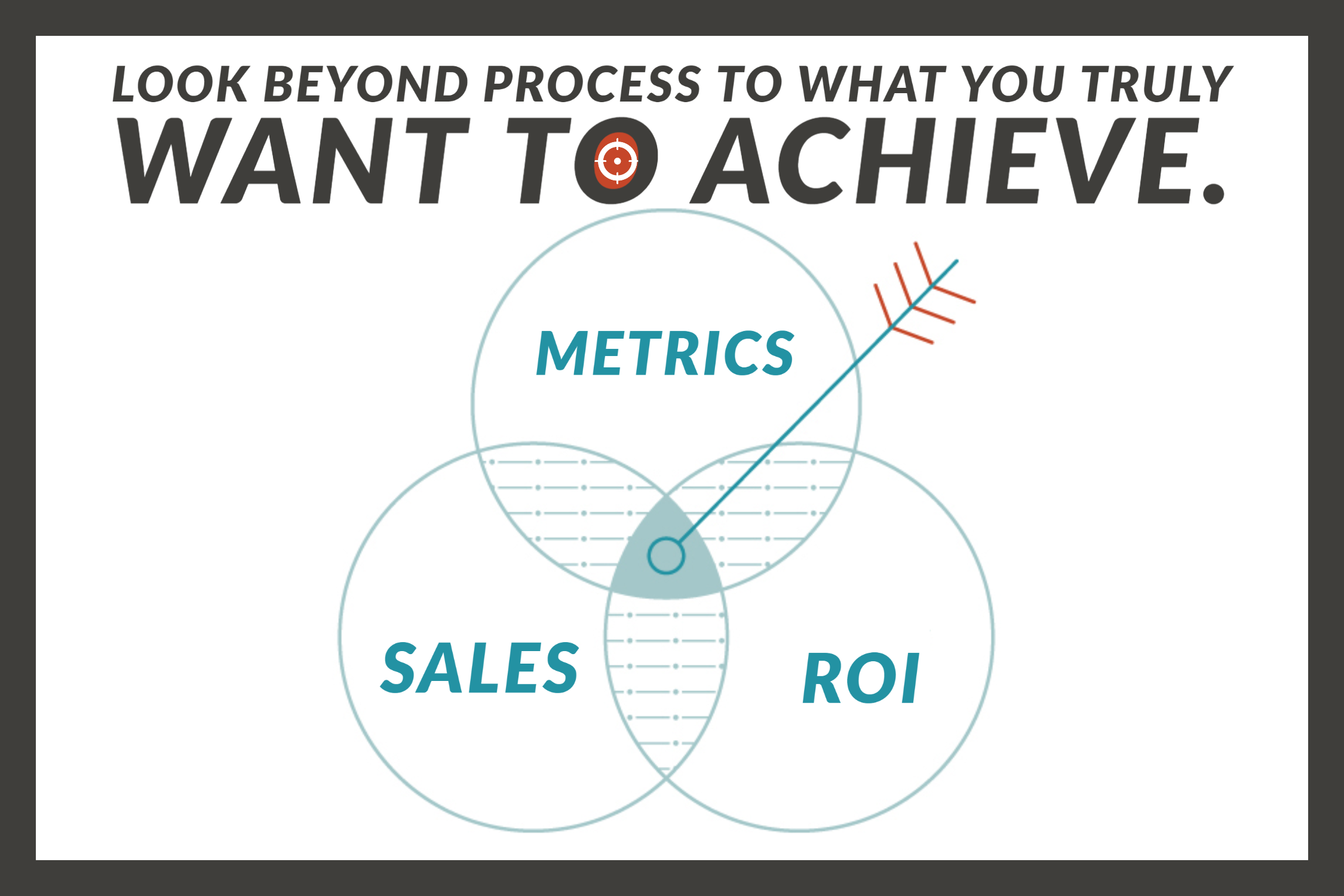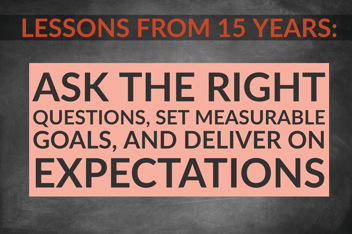Why And How To Set Goals For Your Content Marketing Campaigns

We all constantly set goals, some informal, others documented for our reference and for others. As a runner, I’ve seen many different approaches to setting goals. Some runners have very specific time goals—such as meeting the qualifying time to be able to run the Boston Marathon — while others take a less disciplined approach with goals to simply finish the race and enjoy it. I’ve even seen a runner whose goal was to pet 200 dogs in the course of a half-marathon as a fundraising endeavor.
Every runner sets goals based on what he or she wants from the race. It makes it easier to stay focused during the months of training leading up to the big event.
Your marketing strategy and individual campaigns also need goals in order to ensure they are focused on achieving the right outcomes, though I’d advise being a little more formal and ambitious than “just finish.”
(Want a quick concise look at our approach to setting goals and reporting results? Download our problem/solution paper — Analysis Mistake: Not Having Meaningful Goals To Measure Against.)
Why should you set goals for content marketing?
The simple answer to this question is that goals are like the destination on a road trip: If you don’t know where you’re going, you’ll never get there. A content marketing strategy requires a destination, a target, something to aim for, or else you may simply wander aimlessly trying random tactics and venturing into new channels, but with no idea what to expect.
Granted, that can be a great way to take a road trip, but it’s not so great when you have limited time, limited resources and a boss to answer to at the end of the journey.
Setting goals for your content marketing strategy provides you with landmarks to guide decision making, benchmarks for measuring success, and a focus on the objectives that matter most.
That’s why marketers who set goals are more than four times more likely to report success.
Another key reason for marketers to set defined goals and report on their progress is this: The rest of the company operates on data and goals – not creative ideas and gut feelings. Marketing needs to follow suit in order to prove to the executive suite that it is providing a verifiable return on investment and that the budget allocated to marketing is imperative in continuing to meet corporate goals.
Measuring and reporting on goals that reflect corporate objectives helps you establish the importance of continuing to fund marketing efforts. It makes the results and impact of marketing campaigns less abstract to decision makers when budget time rolls around.
What kinds of goals should you set for your content marketing campaigns?
The temptation in marketing is to simply set goals using the metrics we are most familiar with in our day-to-day jobs—things like website traffic, lead generation, email click-through rates, and social media engagement. But while those are important for fine-tuning specific tactics and content for each channel, the first goals you need to establish, before planning out your marketing strategy or individual campaigns, need to reflect the overall goals of your company.
The first goals you need to determine are sales and revenue goals. These are the ultimate markers of a successful marketing program, because they are a direct correlation to the success of the company. And they fall into line with the kinds of marketing metrics the executive suite wants to see at the end of the day— metrics like customer acquisition cost and customer lifetime value..
You see, 73 percent of executives don’t believe
that marketers are focused enough on results to truly drive incremental
customer demand. If you want to convince them that you are, then formalize those results with goals that match theirs.
You will still want goals that relate to more marketing-specific metrics as well. I’m not saying to disregard those. Instead, approach your goals for web traffic, lead generation and specific channels, such as social media following or email click-through rates from the perspective of what do each of those individual tactics and campaigns need to achieve in order to realize your corporate sales and revenue goals.
From a marketing director’s management standpoint, you’ll also want to document content creation goals and deadlines to guide the actual work, whether working with an all in-house staff or utilizing the resources of freelancers or an outside agency. Documenting your goals, timeline and deadline ensures everyone knows the plan and is working together to meet it.
How do you set goals for content marketing campaigns?
Now that you know what types of goals you should set, let’s talk about how to do so.
One of the easiest ways to visualize the process is with this video I created that walks you through a scenario, step by step.
In a nutshell, the process involves starting from your ultimate sales and revenue goal, and working backward from there.
A very simplified example:
Your sales/revenue goal is 5 new customers per month.
If you know that your typical conversion rate from qualified lead to customer is 1 in 10, then you need 50 qualified leads per month.
If you know that you typically need 100 new leads to get 50 who are qualified, then you need 100 new leads per month.
If you know that to capture 100 leads, you typically need 1,000 website visits, then you need 1,000 website visits per month.
And if you know that each new blog post you publish typically gains 200 visits in a month, then you need at least 5 new blog posts each month.
So, in this overly simplified scenario:
-
Your content creation goal would be 5 new blog posts each month.
-
Your marketing tactics goals would be 1,000 website visits and 100 new leads.
-
Your conversion goal would be 50 marketing-qualified leads sent to sales.
-
Your sales goal would be 5 new customers.
An adjunct to your overall goal setting for your marketing department should be a joint effort with sales in defining how your goals and their goals work together. The final product should be a Service Level Agreement, a document that spells out expectations for both departments regarding how many leads marketing will provide (and what defines a “qualified” lead), as well as what obligations sales has to follow through with each lead. (Download our template agreement to help you calculate lead goals for sales and marketing.)
Establish measurement and reporting based on those goals
While goal setting is an important first step in developing your marketing strategies and campaigns, there is an equally important final step: reporting and analysis.
Using closed-loop marketing with a provider such as HubSpot, you can easily run a myriad of reports on a daily, weekly or monthly basis to monitor your current statistics. Establish a set routine for reporting to your team and your executive suite how each of your chosen metrics is doing compared to the goals that have been set. This establishes both accountability within your sales and marketing teams and an opportunity to prove growth and ROI<https://www.jonespr.net/inboundaccelerator/proven-roi-backs-up-marketing-budget-requests> to the CEO, CFO and other management officials.
As you review your reports, investigate areas in which targets are not being met and drill down to find the weaknesses. For example, if your number of newly-generated leads is behind goal, look at each individual channel: social media, email marketing, search engines, etc. Which channels are failing to bring in enough visitors? Which ones are attracting visitors, but failing to convert them to leads? Which ones are doing well, and why? In addition to reviewing all of your channels, consider the entire sales funnel. Where in the funnel are you losing prospects?
By identifying revenue goals and the marketing performance needed to reach those goals, your month-to-month or day-to-day metrics take on new meaning, and you gain the ability to use those metrics to improve your methods in order to increase company revenues.
At the end of the race, that runner I talked about in the beginning is going to look back at their time, the conditions, their placing, and some will even pick apart the race mile by mile to look for what went well, where he should have grabbed a little more Gatorade early on or maybe moved ahead of the pace group she was using to help her keep from using too much energy at the start. And chances are good, the next goals will be forming before the stinky running shorts have made it through the laundry. Just like your reporting, analysis, and next round of goal setting for your marketing program: wash, rinse, repeat.
Are you looking for resources to help you get a head start on the goal setting process?
Here are few I think could be helpful — all available from our Inbound Marketing Learning Library:
-
Analysis Mistake: Not Having Meaningful Goals To Measure Against Whitepaper
-
The Data You Need To Know: JONES & HubSpot Analysis Solutions
And I’m always willing to chat if you want to bounce ideas around in a no-obligation consultation call. Schedule some time with me here, and we can talk about the kinds of goals your marketing program needs to reach the finish line first.
-1.png?width=1652&height=294&name=Jones(RGB)-1.png)













